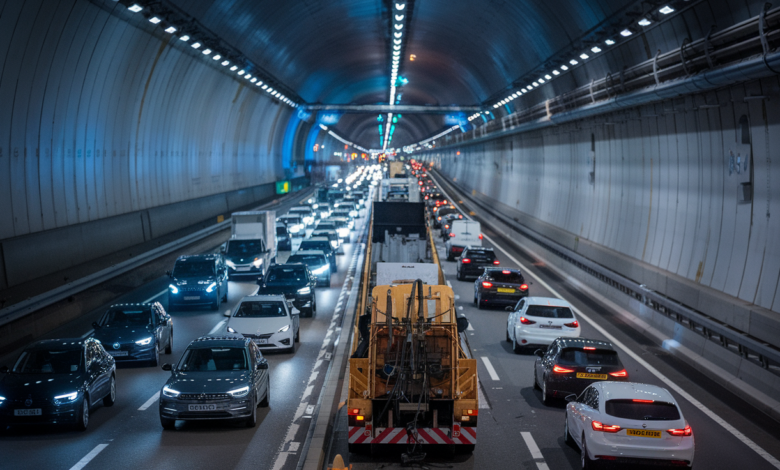Managing Traffic in Dartford Tunnel: Tips and Updates for Every Driver

Traffic in Dartford Tunnel can be tricky, especially during rush hours and holiday seasons. If you drive through this busy crossing, it is important to plan your journey ahead. Many drivers face delays because of accidents, roadworks, or just high volumes of cars and lorries. Knowing the latest updates about traffic in Dartford Tunnel can save you time and stress. You can check live traffic reports, listen to local news, or use route planner apps to find the fastest way through. Even small delays can affect your schedule, so being prepared helps you stay calm and reach your destination on time. Families, commuters, and delivery drivers all need to be aware of the conditions here because this crossing is one of the busiest in the UK. Simple tips like leaving earlier, avoiding peak hours, or using alternative routes can make a big difference.
Watching traffic in Dartford Tunnel closely is key for a smooth journey. Many people underestimate how quickly jams can form in the tunnel, especially when there is heavy rain, accidents, or maintenance work. By staying updated, you can make smart decisions, like taking a different bridge or planning breaks before your trip. Tools like traffic cameras, mobile apps, and radio updates show real-time situations, helping you avoid long waits. Drivers should also follow safety rules strictly, because small mistakes can lead to bigger delays. If you drive a commercial vehicle, check specific rules for lorries or vans that use the tunnel. Planning your route around traffic in Dartford Tunnel not only saves time but also reduces frustration and stress. Learning simple strategies like understanding peak hours, watching for road signs, and staying alert can make every trip smoother and safer.
Understanding Traffic in Dartford Tunnel
Traffic in Dartford Tunnel is something that every driver notices, because it is always busy with thousands of vehicles passing each day. The tunnel connects north and south routes over the River Thames and is a key link for commuters and businesses. Traffic in Dartford Tunnel often builds up when there are roadworks, accidents, or even simple breakdowns inside the tunnel. These issues can quickly slow down the flow of cars and lorries, causing long queues. Many drivers say that peak hours, like early mornings and late afternoons, are the toughest times to travel. By knowing how traffic in Dartford Tunnel changes during the day, you can plan ahead and avoid the worst delays. Simple habits like checking live traffic updates or leaving earlier can help reduce stress and make your journey smoother and faster.
Best Times to Avoid Traffic in Dartford Tunnel
Traffic in Dartford Tunnel is always heavier at certain hours, especially when people go to work or come back home. Early morning between 7 am and 9 am and evening from 4 pm to 6 pm are the busiest times, with long queues on both sides of the crossing. If you want a smoother ride, the best idea is to travel during off-peak hours like mid-morning or later in the evening. Weekends can also bring heavy traffic, especially when families travel or lorries move goods across the country. Planning around these times makes a big difference because you save fuel, time, and stress. Traffic in Dartford Tunnel is more than just a daily wait; it is a pattern you can learn. Once you know these patterns, you can choose smarter times and enjoy a much easier drive across this busy link.
How to Check Real-Time Traffic in Dartford Tunnel
Traffic in Dartford Tunnel can change within minutes, which is why checking real-time updates is so important. Drivers can use mobile apps, GPS systems, and online traffic maps to see what is happening before they even start their journey. Live traffic cameras also show if the tunnel is flowing smoothly or if there are delays. Radio stations often give updates during peak hours, which helps drivers make quick choices about their routes. By checking these tools, you can decide whether to stay on your planned road or take an alternative. Traffic in Dartford Tunnel does not have to catch you by surprise if you plan ahead. Even a few minutes of checking can save you from sitting in long queues. Staying updated means you can travel with less stress and reach your destination on time without big delays.
Tips for a Stress-Free Drive Through Dartford Tunnel
Traffic in Dartford Tunnel may seem stressful, but with smart driving habits, your journey can be much easier. Always check your route before you leave, and if possible, avoid travelling during peak times. Keep extra time in your schedule so delays do not make you worried or rushed. Stay calm while driving, because rushing or changing lanes too quickly can cause more problems for everyone. Listen to traffic updates on the radio or check your phone for alerts while safely parked. Carry water, snacks, and music if you expect longer waits, as these little things can keep you more relaxed. Traffic in Dartford Tunnel can test your patience, but a calm and prepared driver will always handle it better. With the right mindset and planning, even busy tunnel traffic becomes much easier to manage.
Common Causes of Delays in Dartford Tunnel
Traffic in Dartford Tunnel is often slowed down by a few common issues. Roadworks are one of the biggest reasons because lanes can be closed, and speed limits reduced. Accidents, even small ones, can quickly block lanes and create long queues behind. Breakdowns also cause delays, as vehicles need to be moved safely out of the tunnel. Weather plays a role too, since heavy rain or fog can make drivers slow down. During holiday times, the number of cars and lorries on the road also goes up, making the tunnel even busier. All these reasons add up to create frustrating journeys for drivers. Traffic in Dartford Tunnel will never fully disappear, but by knowing these common causes, drivers can prepare better and avoid the worst situations. Awareness helps make travelling smoother, even when the tunnel gets very crowded.
Safe Driving Practices While in Dartford Tunnel
Traffic in Dartford Tunnel requires drivers to stay extra careful because of its busy and closed space. Always keep a safe distance from the car in front of you, since sudden stops can happen inside the tunnel. Follow the speed limit clearly marked on signs, as going too fast can be very dangerous. Keep your headlights on so other drivers can see you well, especially in darker parts. Never change lanes suddenly, because it confuses other drivers and can cause accidents. Make sure your car is in good condition before entering the tunnel, as breakdowns inside create long delays. Traffic in Dartford Tunnel is challenging, but safe driving keeps you and others protected. By following these simple rules, you help reduce risks and ensure smoother journeys for everyone travelling through this important route every day.
Alternative Routes When Traffic in Dartford Tunnel is Heavy
Traffic in Dartford Tunnel can sometimes be so heavy that taking another route is a better idea. One option is to use the Blackwall Tunnel further west, though this can also get busy during peak hours. Another choice is the Woolwich Ferry, which is free but works only at certain times of the day. For longer trips, drivers might consider crossing further away at bridges like Tower Bridge or even further upriver. While these routes can add extra miles, they sometimes save time when the tunnel is blocked or slow. Checking a map app helps you see the best choice in real-time. Traffic in Dartford Tunnel is often the fastest route, but not always the easiest. Having knowledge of alternatives gives you more control and helps you avoid being stuck in long queues unnecessarily.
How Technology Helps Monitor Traffic in Dartford Tunnel
Traffic in Dartford Tunnel is now easier to manage because of new technology tools. Live cameras, digital signs, and real-time maps help drivers understand the situation before entering. Mobile apps like Google Maps or Waze give alerts about accidents, closures, or long queues inside the tunnel. Many drivers also use sat-nav systems that automatically suggest faster routes when traffic is heavy. On the roads leading to the tunnel, big screens warn drivers about delays and give time estimates. These tools save a lot of frustration because they guide drivers to make better decisions quickly. Traffic in Dartford Tunnel may never fully disappear, but with technology, you can plan smarter and avoid the worst delays. Using these tools daily makes driving less stressful, faster, and safer for everyone on this busy crossing.
Conclusion
Traffic in Dartford Tunnel will always be a challenge, but smart planning makes it easier. Drivers who check live updates, pick better times, and follow safe habits can save time and stress. The tunnel is a key link for work, travel, and business, so it will stay busy. But learning to manage it means your trip can be smooth instead of frustrating.
Every driver has the power to handle traffic in Dartford Tunnel better. Simple actions like planning early, using apps, and keeping calm in queues make a big difference. The tunnel may be busy, but being prepared turns a hard drive into a safe and easy journey. With small steps, anyone can travel this busy route with less worry and more confidence.
FAQs
Q: Why is traffic in Dartford Tunnel always busy?
A: It is busy because many cars and lorries use it every day, and it is a main crossing over the River Thames.
Q: What time is best to travel through Dartford Tunnel?
A: Mid-morning or late evening is best, as rush hours are usually very crowded.
Q: How can I check live traffic in Dartford Tunnel?
A: You can use mobile apps, traffic cameras, or radio updates to see real-time conditions.
Q: What causes delays in Dartford Tunnel?
A: Delays often happen from roadworks, accidents, breakdowns, and heavy traffic during peak hours.
Q: Are there other routes if Dartford Tunnel is blocked?
A: Yes, drivers can use Blackwall Tunnel, Woolwich Ferry, or other bridges further away.



